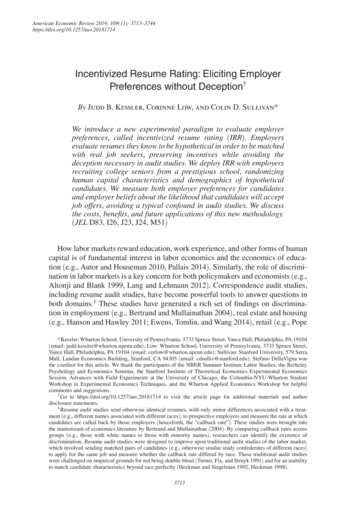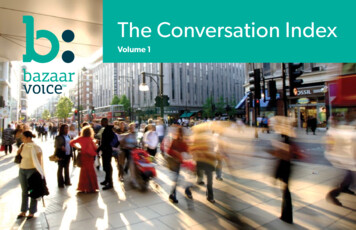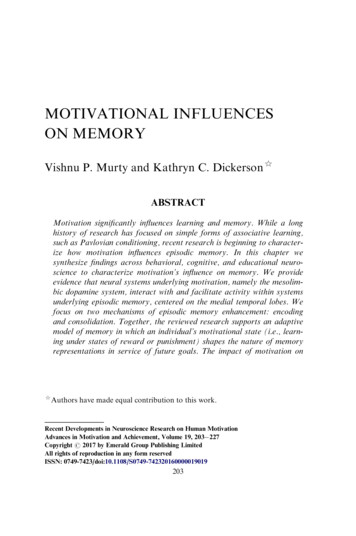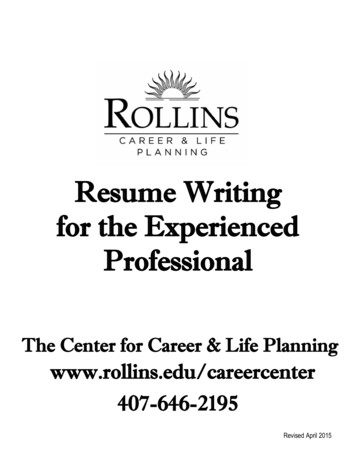
Transcription
American Economic Review 2019, 109(11): entivized Resume Rating: Eliciting EmployerPreferences without Deception†By Judd B. Kessler, Corinne Low, and Colin D. Sullivan*We introduce a new experimental paradigm to evaluate employerpreferences, called incentivized resume rating (IRR). Employersevaluate resumes they know to be hypothetical in order to be matchedwith real job seekers, preserving incentives while avoiding thedeception necessary in audit studies. We deploy IRR with employersrecruiting college seniors from a prestigious school, randomizinghuman capital characteristics and demographics of hypotheticalcandidates. We measure both employer preferences for candidatesand employer beliefs about the likelihood that candidates will acceptjob offers, avoiding a typical confound in audit studies. We discussthe costs, benefits, and future applications of this new methodology.(JEL D83, I26, J23, J24, M51)How labor markets reward education, work experience, and other forms of humancapital is of fundamental interest in labor economics and the economics of education (e.g., Autor and Houseman 2010, Pallais 2014). Similarly, the role of discrimination in labor markets is a key concern for both policymakers and economists (e.g.,Altonji and Blank 1999, Lang and Lehmann 2012). Correspondence audit studies,including resume audit studies, have become powerful tools to answer questions inboth domains.1 These studies have generated a rich set of findings on discrimination in employment (e.g., Bertrand and Mullainathan 2004), real estate and housing(e.g., Hanson and Hawley 2011; Ewens, Tomlin, and Wang 2014), retail (e.g., Pope* Kessler: Wharton School, University of Pennsylvania, 3733 Spruce Street, Vance Hall, Philadelphia, PA 19104(email: judd.kessler@wharton.upenn.edu); Low: Wharton School, University of Pennsylvania, 3733 Spruce Street,Vance Hall, Philadelphia, PA 19104 (email: corlow@wharton.upenn.edu); Sullivan: Stanford University, 579 SerraMall, Landau Economics Building, Stanford, CA 94305 (email: cdsulliv@stanford.edu). Stefano DellaVigna wasthe coeditor for this article. We thank the participants of the NBER Summer Institute Labor Studies, the BerkeleyPsychology and Economics Seminar, the Stanford Institute of Theoretical Economics Experimental EconomicsSession, Advances with Field Experiments at the University of Chicago, the Columbia-NYU-Wharton StudentWorkshop in Experimental Economics Techniques, and the Wharton Applied Economics Workshop for helpfulcomments and suggestions.†Go to https://doi.org/10.1257/aer.20181714 to visit the article page for additional materials and authordisclosure statements.1Resume audit studies send otherwise identical resumes, with only minor differences associated with a treatment (e.g., different names associated with different races), to prospective employers and measure the rate at whichcandidates are called back by those employers (henceforth, the “callback rate”). These studies were brought intothe mainstream of economics literature by Bertrand and Mullainathan (2004). By comparing callback rates acrossgroups (e.g., those with white names to those with minority names), researchers can identify the existence ofdiscrimination. Resume audit studies were designed to improve upon traditional audit studies of the labor market,which involved sending matched pairs of candidates (e.g., otherwise similar study confederates of different races)to apply for the same job and measure whether the callback rate differed by race. These traditional audit studieswere challenged on empirical grounds for not being double-blind (Turner, Fix, and Struyk 1991) and for an inabilityto match candidate characteristics beyond race perfectly (Heckman and Siegelman 1992, Heckman 1998).3713
3714THE AMERICAN ECONOMIC REVIEWNOVEMBER 2019and Sydnor 2011, Zussman 2013), and other settings (see Bertrand and Duflo 2016).More recently, resume audit studies have been used to investigate how employersrespond to other characteristics of job candidates, including unemployment spells(Kroft, Lange, and Notowidigdo 2013; Eriksson and Rooth 2014; Nunley et al.2017), for-profit college credentials (Darolia et al. 2015, Deming et al. 2016), college selectivity (Gaddis 2015), and military service (Kleykamp 2009).Despite the strengths of this workhorse methodology, resume audit studies aresubject to two major concerns. First, they use deception, generally consideredproblematic within economics (Ortmann and Hertwig 2002, Hamermesh 2012).Employers in resume audit studies waste time evaluating fake resumes and pursuing nonexistent candidates. If fake resumes systematically differ from real resumes,employers could become wary of certain types of resumes sent out by researchers,harming both the validity of future research and real job seekers whose resumesare similar to those sent by researchers. These concerns about deception becomemore pronounced as the method becomes more popular.2 To our knowledge, auditand correspondence audit studies are the only experiments within economics forwhich deception is currently permitted, presumably because of the importance ofthe underlying research questions and the absence of a method to answer them without deception.A second concern arising from resume audit studies is their use of “callbackrates” (i.e., the rates at which employers call back fake candidates) as the outcomemeasure that proxies for employer interest in candidates. Since recruiting candidates is costly, firms may be reluctant to pursue candidates who will be unlikely toaccept a position if offered. Callback rates may therefore conflate an employer’sinterest in a candidate with the employer’s expectation that the candidate wouldaccept a job if offered one.3 This confound might contribute to counterintuitiveresults in the resume audit literature. For example, resume audit studies typicallyfind higher callback rates for unemployed than employed candidates (Kroft, Lange,and Notowidigdo 2013; Nunley et al. 2017, 2014; Farber et al. 2018), results thatseem much more sensible when considering this potential role of job acceptance. Inaddition, callback rates can only identify preferences at one point in the quality distribution (i.e., at the threshold at which employers decide to call back candidates).While empirically relevant, results at this callback threshold may not be generalizable (Heckman 1998, Neumark 2012). To better understand the underlying structureof employer preferences, we may also care about how employers respond to candidate characteristics at other points in the distribution of candidate quality.In this paper, we introduce a new experimental paradigm, called incentivizedresume rating (IRR), which avoids these concerns. Instead of sending fake resumesto employers, IRR invites employers to evaluate resumes known to be hypothetical(avoiding deception) and provides incentives by matching employers with real job2Baert (2018) notes 90 resume audit studies focused on discrimination against protected classes in labor markets alone between 2005 and 2016. Many studies are run in the same venues (e.g., specific online job boards),making it more likely that employers will learn to be skeptical of certain types of resumes. These harms might beparticularly relevant if employers become aware of the existence of such research. For example, employers mayknow about resume audit studies since they can be used as legal evidence of discrimination (Neumark 2012).3Researchers who use audit studies aim to mitigate such concerns through the content of their resumes: e.g.,Bertrand and Mullainathan (2004, p. 995) notes that the authors attempted to construct high-quality resumes thatdid not lead candidates to be “overqualified.”
VOL. 109 NO. 11KESSLER ET AL.: INCENTIVIZED RESUME RATING3715seekers based on employers’ evaluations of the hypothetical resumes. Rather thanrelying on binary callback decisions, IRR can elicit much richer information aboutemployer preferences; any information that can be used to improve the quality ofthe match between employers’ preferences and real job seekers can be elicited fromemployers in an incentivized way. In addition, IRR gives researchers the ability toelicit a single employer’s preferences over multiple resumes, to randomize manycandidate characteristics simultaneously, and to collect supplemental data about theemployers reviewing resumes and their firms. Finally, IRR allows researchers tostudy employers who would not respond to unsolicited resumes.We deploy IRR in partnership with the University of Pennsylvania (Penn) CareerServices office to study the preferences of employers hiring graduating seniorsthrough on-campus recruiting. This market has been unexplored by the resume auditliterature since firms in this market hire through their relationships with schoolsrather than by responding to cold resumes. Our implementation of IRR askedemployers to rate hypothetical candidates on two dimensions: (i) how interestedthey would be in hiring the candidate and (ii) the likelihood that the candidate wouldaccept a job offer if given one. In particular, employers were asked to report theirinterest in hiring a candidate on a 10-point Likert scale under the assumption thatthe candidate would accept the job if offered, mitigating concerns about a confoundrelated to the likelihood of accepting the job. Employers were additionally askedthe likelihood that the candidate would accept a job offer on a 10-point Likert scale.Both responses were used to match employers with real Penn graduating seniors.We find that employers value higher grade point averages as well as the qualityand quantity of summer internship experiences. Employers place extra value onprestigious and substantive internships but do not appear to value summer jobs thatPenn students typically take for a paycheck, rather than to develop human capitalfor a future career, such as barista, server, or cashier. This result suggests a potentialbenefit on the post-graduate job market for students who can afford to take unpaidor low-pay internships during the summer rather than needing to work for an hourlywage.Our granular measure of hiring interest allows us to consider how employer preferences for candidate characteristics respond to changes in overall candidate quality.Most of the preferences we identify maintain sign and significance across the distribution of candidate quality, but we find that responses to major and work experienceare most pronounced toward the middle of the quality distribution and smaller inthe tails.While we do not find that employers are more or less interested in female andminority candidates on average, we find some evidence of discrimination againstwhite women and minority men among employers looking to hire candidates withScience, Engineering, and Math majors.4 Employers in our study report having a4We find suggestive evidence that discrimination in hiring interest is due to implicit bias by observing howdiscrimination changes as employers evaluate multiple resumes. In addition, consistent with results from the resumeaudit literature finding lower returns to quality for minority candidates (see Bertrand and Mullainathan 2004), wealso find that, relative to white males, other candidates receive a lower return to work experience at prestigiousinternships.
3716THE AMERICAN ECONOMIC REVIEWNOVEMBER 2019positive preference for diversity in hiring.5 In addition, employers report that whitefemale candidates are less likely to accept job offers than their white male counterparts, suggesting a novel channel for discrimination.Of course, the IRR method also comes with some drawbacks. First, while weattempt to directly identify employer interest in a candidate, our Likert scale measure is not a step in the hiring process and thus, in our implementation of IRR, wecannot draw a direct link between our Likert scale measure and hiring outcomes.However, we imagine future IRR studies could make advances on this front (e.g., byasking employers to guarantee interviews to matched candidates). Second, becausethe incentives in our study are similar but not identical to those in the hiring process,we cannot be sure that employers evaluate our hypothetical resumes with the samerigor or using the same criteria as they would real resumes. Again, we hope futurework might validate that the time and attention spent on resumes in the IRR paradigm is similar to resumes evaluated as part of standard recruiting processes.Our implementation of IRR was the first of its kind and thus left room forimprovement on a few fronts. For example, as discussed in detail in Section III, weattempted to replicate our study at the University of Pittsburgh to evaluate preferences of employers more like those traditionally targeted by resume audit studies.We underestimated how much Pitt employers needed candidates with specific majorsand backgrounds, however, and a large fraction of resumes that were shown to Pittemployers were immediately disqualified based on major. This mistake resulted inhighly attenuated estimates. Future implementations of IRR should more carefullytailor the variables for their hypothetical resumes to the needs of the employersbeing studied. We emphasize other lessons from our implementation in Section IV.Despite the limitations of IRR, our results highlight that the method can be usedto elicit employer preferences and suggest that it can also be used to detect discrimination. Consequently, we hope IRR provides a path forward for those interested instudying labor markets without using deception. The rest of the paper proceeds asfollows. Section I describes in detail how we implement our IRR study; Section IIreports on the results from Penn and compares them to extant literature; Section IIIdescribes our attempted replication at Pitt; and Section IV concludes.I. Study DesignIn this section, we describe our implementation of IRR, which combines theincentives and ecological validity of the field with the control of the laboratory.In Section IA, we outline how we recruit employers who are in the market to hireelite college graduates. In Section IB, we describe how we provide employers withincentives for reporting preferences without introducing deception. In Section IC,we detail how we created the hypothetical resumes and describe the extensive variation in candidate characteristics that we included in the experiment, including gradepoint average and major, previous work experience, skills, and race and gender.5In a survey that employers complete after evaluating resumes in our study, over 90 percent of employers reportthat both “seeking to increase gender diversity/representation of women” and “seeking to increase racial diversity”factor into their hiring decisions, and 82 percent of employers rate both of these factors at 5 or above on a Likertscale from 1 “Do not consider at all” to 10 “This is among the most important things I consider.”
VOL. 109 NO. 11KESSLER ET AL.: INCENTIVIZED RESUME RATING3717In Section ID, we highlight the two questions that we asked subjects about eachhypothetical resume, which allowed us to get a granular measure of interest in acandidate without a confound from the likelihood that the candidate would accepta job if offered.A. Employers and RecruitmentIRR allows researchers to recruit employers in the market for candidates fromparticular institutions and those who do not screen unsolicited resumes and thusmay be hard, or impossible, to study in audit or resume audit studies. To leverage this benefit of the experimental paradigm, we partnered with the University ofPennsylvania (Penn) Career Services office to identify employers recruiting highlyskilled generalists from the Penn graduating class.Penn Career Services sent invitation emails (see online Appendix Figure A.1 forrecruitment email) in two waves during the 2016–2017 academic year to employerswho historically recruited Penn seniors (e.g., firms that recruited on campus, regularly attended career fairs, or otherwise hired students). The first wave was aroundthe time of on-campus recruiting in the fall of 2016. The second wave was aroundthe time of career-fair recruiting in the spring of 2017. In both waves, the recruitment email invited employers to use “a new tool that can help you to identify potential job candidates.” While the recruitment email and the information that employersreceived before rating resumes (see online Appendix Figure A.3 for instructions)noted that anonymized data from employer responses would be used for researchpurposes, this was framed as secondary. The recruitment process and survey toolitself both emphasized that employers were using new recruitment software. For thisreason, we note that our study has the ecological validity of a field experiment.6Aswas outlined in the recruitment email (and described in detail in Section IB), eachemployer’s one and only incentive for participating in the study is to receive 10resumes of job seekers that match the preferences they report through rating thehypothetical resumes.B. IncentivesThe main innovation of IRR is its method for incentivized preference elicitation,a variant of a method pioneered by Low (2019) in a different context. In its mostgeneral form, the method asks subjects to evaluate candidate profiles, which areknown to be hypothetical, with the understanding that more accurate evaluationswill maximize the value of their participation incentive. In our implementation ofIRR, each employer evaluates 40 hypothetical candidate resumes and their participation incentive is a packet of 10 resumes of real job seekers, from a large poolof Penn seniors, selected based on the employer’s evaluations.7 Consequently, the6Indeed, the only thing that differentiates our study from a “natural field experiment” as defined by Harrisonand List (2004) is that subjects know that academic research is ostensibly taking place, even though it is framed assecondary relative to the incentives in the experiment.7The recruitment email (see online Appendix Figure A.1) stated: “the tool uses a newly developed machine-learning algorithm to identify candidates who would be a particularly good fit for your job based on your evaluations.” We
3718THE AMERICAN ECONOMIC REVIEWNOVEMBER 2019p articipation incentive in our study becomes more valuable as employers’ evaluations of candidates better reflect their true preferences for candidates.8A key design decision to help ensure subjects in our study truthfully and accurately report their preferences is that we provide no additional incentive (i.e., beyondthe resumes of the 10 real job seekers) for participating in the study, which took amedian of 29.8 minutes to complete. Limiting the incentive to the resumes of 10 jobseekers makes us confident that participants value the incentive, since they have noother reason to participate in the study. Since subjects value the incentive, and sincethe incentive becomes more valuable as preferences are reported more accurately,subjects have good reason to report their preferences accurately.C. Resume Creation and VariationOur implementation of IRR asked each employer to evaluate 40 unique, hypothetical resumes, and it varied multiple candidate characteristics simultaneouslyand independently across resumes, allowing us to estimate employer preferencesover a rich space of baseline candidate characteristics.9 Each of the 40 resumes wasdynamically populated when a subject began the survey tool. As shown in Table 1and described below, we randomly varied a set of candidate characteristics related toeducation; a set of candidate characteristics related to work, leadership, and skills;and the candidate’s race and gender.We made a number of additional design decisions to increase the realism of thehypothetical resumes and to otherwise improve the quality of employer responses.First, we built the hypothetical resumes using components (i.e., work experiences,leadership experiences, and skills) from real resumes of students at Penn. Second,we asked the employers to choose the type of candidates that they were interested inhiring, based on major (see online Appendix Figure A.4). In particular, they couldchoose either “Business (Wharton), Social Sciences, and Humanities” (henceforth,“Humanities and Social Sciences”) or “Science, Engineering, Computer Science,and Math” (henceforth, “STEM”). They were then shown hypothetical resumesfrom the set of majors they selected. As described below, this choice affects a widerange of candidate characteristics: majors, internship experiences, and skills on thehypothetical resumes varied across these two major groups. Third, to enhance realism, and to make the evaluation of the resumes less tedious, we used ten differentresume templates, which we populated with the candidate characteristics and component pieces described below, to generate the 40 hypothetical resumes (see onlinedid not use race or gender preferences when suggesting matches from the candidate pool. The process by which weidentify job seekers based on employer evaluations is described in detail in online Appendix A.3.8In Low (2019), heterosexual male subjects evaluated online dating profiles of hypothetical women with anincentive of receiving advice from an expert dating coach on how to adjust their own online dating profiles to attractthe types of women that they reported preferring. While this type of nonmonetary incentive is new to the laboreconomics literature, it has features in common with incentives in laboratory experiments, in which subjects makechoices (e.g., over monetary payoffs, risk, time, etc.) and the utility they receive from those choices is higher as theirchoices more accurately reflect their preferences.9In a traditional resume audit study, researchers are limited in the number of resumes and the covariance ofcandidate characteristics that they can show to any particular employer. Sending too many fake resumes to the samefirm, or sending resumes with unusual combinations of components, might raise suspicion. For example, Bertrandand Mullainathan (2004) send only four resumes to each firm and create only two quality levels (i.e., a high-qualityresume and a low-quality resume, in which various candidate characteristics vary together).
VOL. 109 NO. 113719KESSLER ET AL.: INCENTIVIZED RESUME RATINGTable 1—Randomization of Resume ComponentsResume componentPersonal informationFirst and last nameEducation informationGPAMajorDegree typeSchool within universityGraduation dateWork experienceFirst jobTitle and employerLocationDescriptionDatesSecond jobTitle and employerLocationDescriptionDatesLeadership experienceFirst and second leadershipTitle and activityLocationDescriptionDatesSkillsSkills listDescriptionAnalysis variableDrawn from list of 50 possible names given selected raceand gender (names in Tables A.1 and A.2)Race drawn randomly from US distribution (65.7% white,16.8% Hispanic, 12.6% black, 4.9% Asian)Gender drawn randomly (50% male, 50% female)Female, white (32.85%)Male, non-white (17.15%)Female, non-white (17.15%)Not a white male (67.15%)Drawn Unif [2.90, 4.00] to second decimal placeDrawn from a list of majors at Penn (Table A.3)BA, BS fixed to randomly drawn majorFixed to randomly drawn majorFixed to upcoming spring (i.e., May 2017)GPAMajor (weights in Table A.3)Wharton (40%)School of Engineering andApplied Science (70%)Drawn from curated list of top internships andregular internshipsFixed to randomly drawn jobFixed to randomly drawn jobBullet points fixed to randomly drawn jobSummer after candidate’s junior year (i.e., 2016)Left blank or drawn from curated list of regularinternships and work-for-money jobs (Table A.5)Fixed to randomly drawn jobFixed to randomly drawn jobBullet points fixed to randomly drawn jobSummer after candidate’s sophomore year (i.e., 2015)Top internship (20/40)Second internship (13/40)Work for money (13/40)Drawn from curated listFixed to randomly drawn leadershipFixed to Philadelphia, PABullet points fixed to randomly drawn leadershipStart and end years randomized within college career, with morerecent experience coming firstDrawn from curated list, with two skills drawn from {Ruby,Python, PHP, Perl} and two skills drawn from {SAS, R, Stata,Matlab} shuffled and added to skills list with probability 25%Technical skills (25%)Notes: Resume components are listed in the order that they appear on hypothetical resumes. Variables in theright-hand column were randomized to test how employers responded to these characteristics. Degree, first job, second job, and skills were drawn from different lists for Humanities and Social Sciences resumes and STEM resumes(except for work-for-money jobs). Name, GPA, work-for-money jobs, and leadership experience were drawn fromthe same lists for both resume types. Weights of characteristics are shown as fractions when they are fixed acrosssubjects (e.g., each subject saw exactly 20/40 resumes with a top internship) and percentages when they representa draw from a probability distribution (e.g., each resume a subject saw had a 32.85 percent chance of being assigneda white female name).Appendix Figure A.5 for a sample resume). We based these templates on real student resume formats (see online Appendix Figure A.6 for examples).10 Fourth, wegave employers short breaks within the study by showing them a progress screenafter each block of ten resumes they evaluated. As described in Section IID andonline Appendix B.4, we use the change in attention induced by these breaks toconstruct tests of implicit bias.10We blurred the text in place of a phone number and email address for all resumes, since we were not interestedin inducing variation in those candidate characteristics.
3720THE AMERICAN ECONOMIC REVIEWNOVEMBER 2019Education Information.—In the education section of the resume, we independently randomized each candidate’s grade point average (GPA) and major. GPAis drawn from a uniform distribution between 2.90 and 4.00, shown to two decimalplaces and never omitted from the resume. Majors are chosen from a list of Pennmajors, with higher probability put on more common majors. Each major was associated with a degree (BA or BS) and with the name of the group or school grantingthe degree within Penn (e.g., “College of Arts and Sciences”). Online AppendixTable A.3 shows the list of majors by major category, school, and the probability thatthe major was used in a resume.Work Experience.—We included realistic work experience components on theresumes. To generate the components, we scraped more than 700 real resumes ofPenn students. We then followed a process described in online Appendix A.2.5 toselect and lightly sanitize work experience components so that they could be randomly assigned to different resumes without generating conflicts or inconsistencies(e.g., we eliminated references to particular majors and to gender). Each work experience component included the associated details from the real resume from whichthe component was drawn, including an employer, position title, location, and a fewdescriptive bullet points.Our goal in randomly assigning these work experience components was to introduce variation along two dimensions: quantity of work experience and qualityof work experience. To randomly assign quantity of work experience, we variedwhether the candidate had an internship only in the summer before senior year, oralso had a job or internship in the summer before junior year. Thus, candidates withmore experience had two jobs on their resume (before junior and senior years),while others had only one (before senior year).To introduce random variation in quality of work experience, we selected workexperience components from three categories: (i) “top internships,” which wereinternships with prestigious firms as defined by being a firm that successfully hiresmany Penn graduates; (ii) “work-for-money” jobs, which were paid jobs that, atleast for Penn students, are unlikely to develop human capital for a future career(e.g., barista, cashier, waiter, etc.); and (iii) “regular” internships, which comprisedall other work experiences.11The first level of quality randomization was to assign each hypothetical resume tohave either a top internship or a regular internship in the first job slot (before senioryear). This allows us to detect the impact of having a higher quality internship.1211See online Appendix Table A.4 for a list of top internship employers and Table A.5 for a list of work-formoney job titles. As described in online Appendix A.2.5, different internships (and top internships) were used foreach major type but the same work-for-money jobs were used for both major types. The logic of varying internshipsby major type was based on the intuition that internships could be interchangeable within each group of majors (e.g.,internships from the Humanities and Social Sciences resumes would not be unusual to see on any other resume fromthat major group) but were unlikely to be interchangeable across major groups (e.g., internships from Humanitiesand Social Sciences resumes would be unusual to see on STEM resumes and vice versa). We used the same set ofwork-for-money jobs for both major types, since these jobs were not linked to a candidate’s field of study.12Since the work experience component was comprised of employer, title, location, and description, a higherquality work experience necessarily reflects all features of this bundle; we did not independently randomize theelements of work experience.
VOL. 109 NO. 11KESSLER ET AL.: INCENTIVIZED RESUME RATING3721The second level of quality randomization was in the kind of job a resume hadin the second job slot (before junior year), if any. Many students may have an economic need to earn money during the summer and thus may be unable to take anunpaid or low-pay internship. To evaluate whe
to match candidate characteristics beyond race perfectly (Heckman and Siegelman 1992, Heckman 1998). . Wharton School, University of Pennsylvania, 3733 Spruce Street, Vance Hall, Philadelphia, PA 19104 (email: judd.kessler@wharton.upenn.edu); Low: Wharton School, University of Pennsylvania, 3733 Spruce Street, . Of course, the IRR method .










